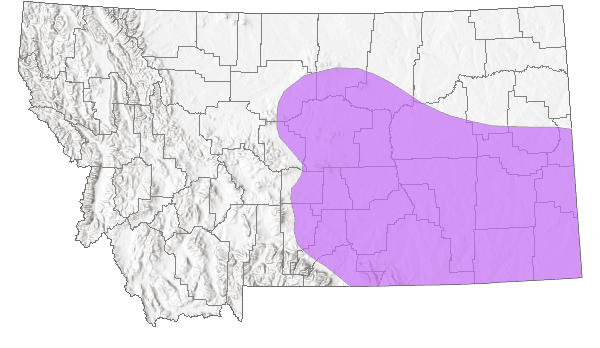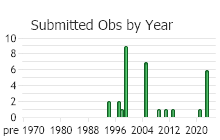View in other NatureServe Network Field Guides
NatureServe
Montana
Utah
Wyoming
Idaho
Wisconsin
British Columbia
South Carolina
Yukon
California
New York
Double Bladderpod - Physaria brassicoides
State Rank Reason (see State Rank above)
Double bladderpod is endemic to a restricted area of the northern Great Plains, and is known in Montana only from a handful of populations. Populations occur on a mix of federal, state and private ownerships. Impacts to the species from livestock grazing and invasive weeds are minimal at this time as the typically steep, sparsely-vegetated habitat is not conducive to grazing. Yellow sweetclover was observed at one location and it may eventually have a negaitive impact on the species.
- Details on Status Ranking and Review
Population Size
Score2-3 - Very Small to Small: Population size is imprecisely known but is believed to be <10,000 individuals.
Range Extent
Score2 - Regional or State Endemic or Small Montana Range: Generally restricted to an area <100,000 sq. miles (equivalent to 2/3 the size of Montana or less) or Montana contributes 50% or more of the species’ range or populations OR limited to 2-3 Sub-basins in Montana.
Area of Occupancy
Score2 - Low: Generally occurring in 4-10 Subwatersheds (6th Code HUC’s).
CommentAdditional populations are probably present within the state.
Environmental Specificity
Score1 - Moderate: Species is restricted to a specific habitat that is more widely distributed or to several restricted habitats and is typically dependent upon relatively unaltered, good-quality habitat (C Values of 5-7).
Trends
ScoreNA - Rank factor not assessed.
Threats
Score0-1 - Low to Medium.
Intrinsic Vulnerability
Score0-1 - Low to Moderate Vulnerability.
Raw Conservation Status Score
Score
7 to 10 total points scored out of a possible 16 (Rarity factors and threats only).
General Description
Double Bladderpod is a perennial herb with numerous ascending stems that are 2-17 cm long and arising from a basal rosette that surmounts a branched crown and large taproot. The basal leaves are 2-8 cm long and are spoon-shaped with long petioles. The few, alternate stem leaves are broadly lance-shaped. Foliage is covered with silvery, star-shaped hairs appressed to the surface. The yellow, stalked flowers are borne at the tops of the stems in a narrow inflorescence that elongates as the fruit matures. Each flower has 4 separate petals that are 9-12 mm long and 4 separate sepals. The ascending, inflated fruits are 1-2 cm long, at least as wide, and flattened on top. They are 2-lobed with the locules (lobes) more deeply defined above than below. There are 2 ovules in each of the locules , attached at the top of the replum (suture between the two locules), and the replum has a linear outline. The style is 6-9 mm long.
Phenology
Flowering takes place in May and early June, and fruiting in June and July.
Diagnostic Characteristics
Physaria brassicoides is distinguished from other bladderpods primarily by its fruit, which is more constricted above than below and has 2 ovules per locule and a narrow, linear-shaped replum. Ovules often abort, making the number of seeds an unreliable diagnostic character, however, ovule number can be determined by counting the funiculi -- the tiny pegs that attach the ovules to the margin of the replum and are visible even after the ovules abort.
Double Bladderpod -
Physaria brassicoides, SOC
*Pedicels are spreading, straight, or sigmoid, 5-20 mm long.
*Fruits inflated
and 2-lobed, 7-10 mm wide. Replum (thin wall that separates the lobes) is narrow and constricted in the middle.
Thick-leaf Bladderpod –
Physaria pachyphylla, SOC
*Pedicels curve upwards (ascend), 3-10 mm long.
*Fruits inflated,
not 2-lobed, and narrowly elliptic to ovoid, 3-6 mm tall. Style is more than half the length of the fruit (silicle).
*Basal leaves have distinct petioles and blades. Blades are spatulate to oblanceolate in shape, nearly 1 mm thick and cupped (but not folded), and with entire margins [key characteristic].
*Plants grow on pinkish or reddish soils derived from limestone on exposed slopes and ridges in valleys.
Species Range
Montana Range
Range Descriptions

 Native
Native
Range Comments
Carter and Powder River counties. MT, ND south to WY, NE (Lesica et al. 2012. Manual of Montana Vascular Plants. BRIT Press. Fort Worth, TX).
Observations in Montana Natural Heritage Program Database
Number of Observations: 31
(Click on the following maps and charts to see full sized version)
Map Help and Descriptions
Relative Density

Recency



 (Observations spanning multiple months or years are excluded from time charts)
(Observations spanning multiple months or years are excluded from time charts)
Habitat
All Montana populations occur on sparsely vegetated, steep, eroding, south-facing slopes of highly dissected breaklands and badlands (Vanderhorst et al. 1998). Substrate parent materials include both sandstone and shale, and these plants sometimes grow at the contact zone where sandstone overlies shale. The soft, eroding shale slopes do not support stable vegetation and have 80-90% exposed substrate. Associates include skunkbush (Rhus aromatica) and yucca (Yucca glauca), Indian ricegrasses (Oryzopsis hymenoides), little bluestem (Schizachyrium scoparium), Chaenactis douglasii and Dalea candida.
On the Custer National Forest, double bladderpod occurs mostly on barren substrate with less than 10 percent vegetation cover. Typical shrubs are Rhus aromatica, and low forms of Amelanchier alnifolia and Prunus virginiana. Clumps of western wheatgrass and little bluestem are present at one site and Oryzopsis hymenoides at another. Typically the upper soil is loose and shifting, and may be bounded above and below by clay or shale bedrock. One subpopulation occurs along a sandy slump just above a roadcut (Heidel and Dueholm 1995).
Ecological Systems Associated with this Species
Ecology
Double bladderpod occurs on sparsely vegetated slopes with a loose surface layer, and does not extend into adjacent grasslands with greater cover (Heidel and Dueholm 1995). This suggests that it prefers less competitive sites, where infiltration in the coarse sand is greater than in clay or shale. Most populations documented in Montana consist of less than 50 plants, which may be attributable to sporadic seed production and/or poor competitive ability.
Management
The steep habitat and sparse vegetation cover is not conducive to grazing, and the species is likely unpalatable (Heidel and Dueholm 1995). Cattle trails dissect one population in Carter County, however the low-growing habit of double bladderpod makes it less vulnerable to grazing (Vanderhorst et al. 1998). Melilotus officinalis (yellow sweet clover) was observed in at least one site. This aggressive colonizer of barren habitats has been noted as a management concern for double bladderpod in North Dakota (Heidel 1990). The introduction and spread of exotic weeds probably constitutes the greatest threat to this species' habitat in Montana. Road maintenance could affect one population that lies on a roadcut.
Threats or Limiting Factors
STATE THREAT SCORE REASON
Threat impact not assigned because threats are not known (MTNHP Threat Assessment 2021).
References
- Literature Cited AboveLegend:
 View Online Publication
View Online Publication Lesica, P., M.T. Lavin, and P.F. Stickney. 2012. Manual of Montana Vascular Plants. Fort Worth, TX: BRIT Press. viii + 771 p.
Lesica, P., M.T. Lavin, and P.F. Stickney. 2012. Manual of Montana Vascular Plants. Fort Worth, TX: BRIT Press. viii + 771 p.
- Additional ReferencesLegend:
 View Online Publication
View Online Publication
Do you know of a citation we're missing? Heidel, B. 1990. Inventory of rare plant species in Theodore Roosevelt National Park, Billings and McKenzie counties, North Dakota. Report to the National Park Service. North Dakota Natural Heritage Inventory, Bismarck, North Dakota. 112 pp.
Heidel, B. 1990. Inventory of rare plant species in Theodore Roosevelt National Park, Billings and McKenzie counties, North Dakota. Report to the National Park Service. North Dakota Natural Heritage Inventory, Bismarck, North Dakota. 112 pp. Heidel, B. L. 1996. Noteworthy collections - Montana. Madrono 43(3):436-440.
Heidel, B. L. 1996. Noteworthy collections - Montana. Madrono 43(3):436-440. Heidel, B.L. and K.H. Dueholm. 1995. Sensitive plant survey in the Sioux District, Custer National Forest, 1994, Carter County, Montana and Harding County, South Dakota. Unpublished report to the Custer National Forest. Montana Natural Heritage Program, Helena, Montana. 95 pp. plus appendices.
Heidel, B.L. and K.H. Dueholm. 1995. Sensitive plant survey in the Sioux District, Custer National Forest, 1994, Carter County, Montana and Harding County, South Dakota. Unpublished report to the Custer National Forest. Montana Natural Heritage Program, Helena, Montana. 95 pp. plus appendices. Lesica, P., M.T. Lavin, and P.F. Stickney. 2022. Manual of Montana Vascular Plants, Second Edition. Fort Worth, TX: BRIT Press. viii + 779 p.
Lesica, P., M.T. Lavin, and P.F. Stickney. 2022. Manual of Montana Vascular Plants, Second Edition. Fort Worth, TX: BRIT Press. viii + 779 p. Mulligan, G.A. 1967. Physaria didymocarpa, P. brassicoides, and P. floribunda (Cruciferae) and their close relatives. Canadian Journal of Botany 46:735-740.
Mulligan, G.A. 1967. Physaria didymocarpa, P. brassicoides, and P. floribunda (Cruciferae) and their close relatives. Canadian Journal of Botany 46:735-740. Vanderhorst, J.P., S.V. Cooper, and B.L. Heidel. 1998. Botanical and vegetation survey of Carter County, Montana. Unpublished report prepared for the Bureau of Land Management. Montana Natural Heritage Program, Helena. 116 pp. + app.
Vanderhorst, J.P., S.V. Cooper, and B.L. Heidel. 1998. Botanical and vegetation survey of Carter County, Montana. Unpublished report prepared for the Bureau of Land Management. Montana Natural Heritage Program, Helena. 116 pp. + app.
- Web Search Engines for Articles on "Double Bladderpod"





